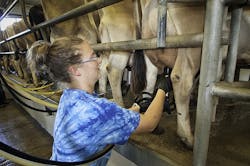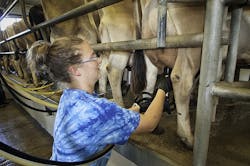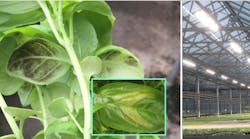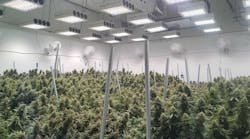Michigan State University documents how long-day lighting in a dairy with closely-controlled intensity from LED sources boosted milk production by 8%.
Michigan State University has announced the results of a long-day lighting (LDL) research project at Wing Acres Dairy in Barry County, MI. Researchers from the school's Biosystems and Agricultural Engineering Department worked with the Michigan Milk Producers Association (MMPA) to study the implications of LED-based LDL on milk production, and the study indicates an 8% increase over the course of a year.
Source: USDA photo by Bob Nichols
We've seen LED-based solid-state lighting (SSL) products used increasingly in life science applications. For example, SSL products from Once Innovations are used to increase productivity on poultry farms. And LED lighting is also being used to improve plant growth in indoor farming applications.
In the dairy research, the team sought to practically validate the LDL principles that have been studied for more than three decades. LDL consists of lengthening that daily light photoperiod to which dairy cows are exposed. Specifically, LDL research has shown better production when herds are exposed to 15–20-fc of light for 16–18 hours, followed by 6–8 hours with light levels below 3 fc.
In the past, Michigan dairies have been unable to fully realize the projected benefits of LDL because of limitations in legacy lighting systems. There have been technical difficulties in installing a system with accurate metering for light levels and precise control of output. But LED-based lighting, sensors, and an automated control system created by the research team overcame the aforementioned challenges to accurately deliver an LDL environment at the 100-cow Wing Acres operation.
The team studied production over the course of 2014 and documented the 8% increase in milk production. And the team sought to document other factors over the course of the year that could have impacted production. For example, the team compared operational practices on the farm to prior years and weather patterns, but found no significant factors outside of the LED lighting that could be responsible for the increase. The team concluded that "the increased milk production at Wing Acres Dairy can be attributed to the LDL system."
The diary had previously used metal halide (MH) lighting in its barn. The LED lighting is delivering significant energy savings as well as better-controlled lighting. Energy expenses for lighting are down 50%. Combined with the increased milk production, such an energy-efficient SSL project will deliver payback to a dairy in just over one year.
The dairy has noted several additional benefits to LED lighting. With MH systems, separate fixtures were required for the low-light period. But the LED fixtures can be dimmed to deliver the below-3-fc level required. Moreover, the LED fixtures are more reliable in the relatively harsh environment and will require much less frequent maintenance, which disrupts the dairy operation. Anecdotally, the farmer also said that the cows seem more docile after the retrofit.






